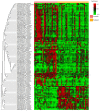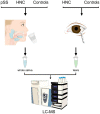Proteomic Profiling of Saliva and Tears in Radiated Head and Neck Cancer Patients as Compared to Primary Sjögren's Syndrome Patients
- PMID: 35409074
- PMCID: PMC8998953
- DOI: 10.3390/ijms23073714
Proteomic Profiling of Saliva and Tears in Radiated Head and Neck Cancer Patients as Compared to Primary Sjögren's Syndrome Patients
Abstract
Patients with head and neck cancer (HNC) and patients with primary Sjögren's syndrome (pSS) may exhibit similar symptoms of dry mouth and dry eyes, as a result of radiotherapy (RT) or a consequence of disease progression. To identify the proteins that may serve as promising disease biomarkers, we analysed saliva and tears from 29 radiated HNC patients and 21 healthy controls, and saliva from 14 pSS patients by mass spectrometry-based proteomics. The study revealed several upregulated, and in some instances overlapping, proteins in the two patient groups. Histone H1.4 and neutrophil collagenase were upregulated in whole saliva of both patient groups, while caspase-14, histone H4, and protein S100-A9 were upregulated in HNC saliva only. In HCN tear fluid, the most highly upregulated protein was mucin-like protein 1. These overexpressed proteins in saliva and tears play central roles in inflammation, host cell injury, activation of reactive oxygen species, and tissue repair. In conclusion, the similarities and differences in overexpressed proteins detected in saliva from HNC and pSS patients may contribute to the overall understanding of the different pathophysiological mechanisms inducing dry mouth. Thus, the recurring proteins identified could possibly serve as future promising biomarkers.
Keywords: Sjögren’s syndrome; biomarkers; head-and-neck cancer; immune response; inflammation; lacrimal glands; meibomian glands; proteomics; radiotherapy; saliva; salivary glands; tear fluid; tissue healing.
Conflict of interest statement
T.P.U. is co-founder and co-owner of The Norwegian dry eye clinic and The clinic of eye health, Oslo, Norway. He has served on the global scientific advisory board for Novartis and Alcon as well as the European advisory board for Shire Pharmaceuticals.
Figures








Similar articles
-
Identification of potential saliva and tear biomarkers in primary Sjögren's syndrome, utilising the extraction of extracellular vesicles and proteomics analysis.Arthritis Res Ther. 2017 Jan 25;19(1):14. doi: 10.1186/s13075-017-1228-x. Arthritis Res Ther. 2017. PMID: 28122643 Free PMC article.
-
Proteomic and histopathological characterisation of sicca subjects and primary Sjögren's syndrome patients reveals promising tear, saliva and extracellular vesicle disease biomarkers.Arthritis Res Ther. 2019 Jul 31;21(1):181. doi: 10.1186/s13075-019-1961-4. Arthritis Res Ther. 2019. PMID: 31366407 Free PMC article.
-
Characterization of Lipids in Saliva, Tears and Minor Salivary Glands of Sjögren's Syndrome Patients Using an HPLC/MS-Based Approach.Int J Mol Sci. 2021 Aug 20;22(16):8997. doi: 10.3390/ijms22168997. Int J Mol Sci. 2021. PMID: 34445702 Free PMC article.
-
The Proteomics of Saliva in Sjögren's Syndrome.Rheum Dis Clin North Am. 2016 Aug;42(3):449-56. doi: 10.1016/j.rdc.2016.03.004. Epub 2016 Jun 21. Rheum Dis Clin North Am. 2016. PMID: 27431347 Free PMC article. Review.
-
The Potential Utility of Salivary and Tear Proteomics to Discriminate Sjögren's Disease from Non-Sjögren's Sicca.Int J Mol Sci. 2023 Dec 15;24(24):17497. doi: 10.3390/ijms242417497. Int J Mol Sci. 2023. PMID: 38139325 Free PMC article. Review.
Cited by
-
The ocular surface tear film as a biomarker for systemic health.Ocul Surf. 2025 Jul;37:283-300. doi: 10.1016/j.jtos.2025.05.005. Epub 2025 May 8. Ocul Surf. 2025. PMID: 40345388 Review.
-
Key Genes of Immunity Associated with Pterygium and Primary Sjögren's Syndrome.Int J Mol Sci. 2023 Jan 20;24(3):2047. doi: 10.3390/ijms24032047. Int J Mol Sci. 2023. PMID: 36768371 Free PMC article.
-
Establishment of a Protocol for CE-MS Based Peptidome Analysis of Human Saliva.Proteomics. 2025 Jul;25(13):e00231. doi: 10.1002/pmic.202400231. Epub 2025 May 27. Proteomics. 2025. PMID: 40420629 Free PMC article.
-
Using machine learning model explanations to identify proteins related to severity of meibomian gland dysfunction.Sci Rep. 2023 Dec 22;13(1):22946. doi: 10.1038/s41598-023-50342-7. Sci Rep. 2023. PMID: 38135766 Free PMC article.
-
Tear Proteomics Approach to Distinguishing Primary from Secondary Sjögren's Syndrome for Dry Eye Patients with Long-Term Instillation of Eyedrops.Int J Mol Sci. 2022 Dec 3;23(23):15239. doi: 10.3390/ijms232315239. Int J Mol Sci. 2022. PMID: 36499565 Free PMC article.
References
-
- Pfister D.G., Spencer S., Adelstein D., Adkins D., Anzai Y., Brizel D.M., Bruce J.Y., Busse P.M., Caudell J.J., Cmelak A.J., et al. Head and Neck Cancers, Version 2.2020, NCCN Clinical Practice Guidelines in Oncology. J. Natl. Compr. Cancer Netw. 2020;18:873–898. doi: 10.6004/jnccn.2020.0031. - DOI - PubMed
-
- Roscher I., Falk R.S., Vos L., Clausen O.P.F., Helsing P., Gjersvik P., Robsahm T.E. Notice of Retraction and Replacement: Roscher et al. Validating 4 Staging Systems for Cutaneous Squamous Cell Carcinoma Using Population-Based Data: A Nested Case-Control Study. JAMA Dermatol. 2018;154:1488–1489. doi: 10.1001/jamadermatol.2018.4023. - DOI - PubMed
-
- Jelonek K., Krzywon A., Jablonska P., Slominska E.M., Smolenski R.T., Polanska J., Rutkowski T., Mrochem-Kwarciak J., Skladowski K., Widlak P. Systemic Effects of Radiotherapy and Concurrent Chemo-Radiotherapy in Head and Neck Cancer Patients—Comparison of Serum Metabolome Profiles. Metabolites. 2020;10:60. doi: 10.3390/metabo10020060. - DOI - PMC - PubMed
MeSH terms
Substances
Grants and funding
LinkOut - more resources
Full Text Sources
Medical
Research Materials
Miscellaneous

